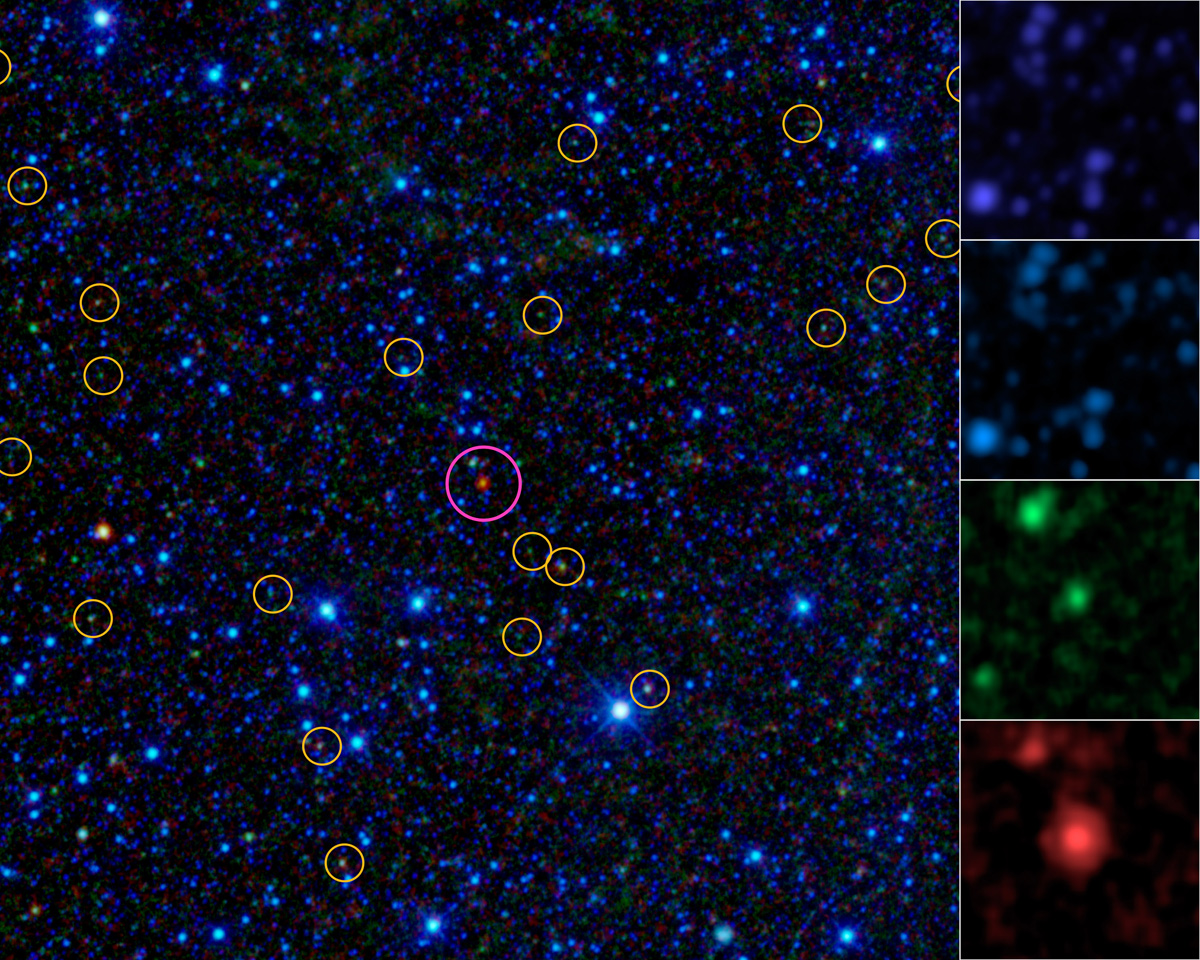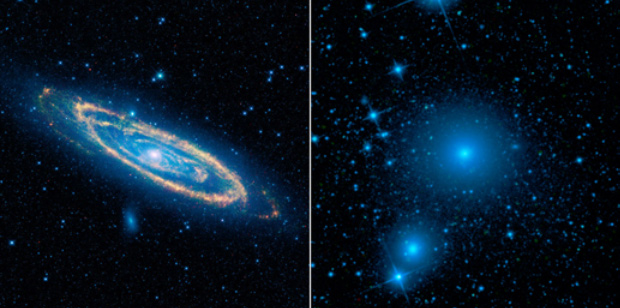Millions of Black Holes Seen by WISE Telescope (Photos)
A WISE 'Eye' on the Whole Sky

The entire sky as mapped by WISE at infrared wavelengths is shown here, with an artist's concept of the WISE satellite superimposed. Image released August 29, 2012.
A Sky Chock-Full of Black Holes

With its all-sky infrared survey, NASA's Wide-field Infrared Survey Explorer, or WISE, has identified millions of quasar candidates. Quasars are supermassive black holes with masses millions to billions times greater than our sun. The black holes "feed" off surrounding gas and dust, pulling the material onto them. As the material falls in on the black hole, it becomes extremely hot and extremely bright. This image zooms in on one small region of the WISE sky, covering an area about three times larger than the moon. The WISE quasar candidates are highlighted with yellow circles. Image released August 29, 2012.
Quasar Drenched in Water Vapor

This artist's concept illustrates a quasar, or feeding black hole, similar to APM 08279+5255, where astronomers discovered huge amounts of water vapor. Gas and dust likely form a torus around the central black hole, with clouds of charged gas above and below. X-rays emerge from the very central region, while thermal infrared radiation is emitted by dust throughout most of the torus. While this figure shows the quasar's torus approximately edge-on, the torus around APM 08279+5255 is likely positioned face-on from our point of view. Image released August 29, 2012.
Exposing Black Holes Disguised in Dust

This zoomed-in view of a portion of the all-sky survey from NASA's Wide-field Infrared Survey Explorer shows a collection of quasar candidates. Quasars are supermassive black holes feeding off gas and dust. The larger yellow circles show WISE quasar candidates; the smaller blue-green circles show quasars found in the previous visible-light Sloan Digital Sky Survey. WISE finds three times as many quasar candidates with a comparable brightness. Thanks to WISE's infrared vision, it picks up previously known bright quasars as well as large numbers of hidden, dusty quasars.
The circular inset images, obtained with NASA's Hubble Space Telescope, show how the new WISE quasars differ from the quasars identified in visible light. Quasars selected in visible light look like stars, as shown in the lower right inset; the cross is a diffraction pattern caused by the bright point source of light. Quasars found by WISE often have more complex appearances, as seen in the Hubble inset near the center. This is because the quasars found by WISE are often obscured or hidden by dust, which blocks their visible light and allows the fainter host galaxy surrounding the black hole to be seen. Image released August 29, 2012.
Galaxies Burn Bright Like High-Wattage 'Light Bulbs'

NASA's Wide-field Infrared Survey Explorer (WISE) has identified about 1,000 extremely obscured objects over the sky, as marked by the magenta symbols. These hot dust-obscured galaxies, or "hot DOGs," are turning out to be among the most luminous, or intrinsically bright objects known, in some cases putting out over 1,000 times more energy than our Milky Way galaxy. Image released August 29, 2012.
WISE Hot DOGs — Extremely Bright and Extremely Rare

This image zooms in on the region around the first "hot DOG" (red object in magenta circle), discovered by NASA's Wide-field Infrared Survey Explorer, or WISE. Hot DOGs are hot dust-obscured galaxies. Follow-up observations with the W.M. Keck Observatory on Mauna Kea, Hawaii, show this source is over 10 billion light-years away. It puts out at least 37 trillion times as much energy as the sun.
WISE has identified 1,000 similar candidate objects over the entire sky (magenta dots). These extremely dusty, brilliant objects are much more rare than the millions of active supermassive black holes also found by WISE (yellow circles). Image released August 29, 2012.
Homing in on 'Hot Dogs'

This image is a portion of the all-sky survey from NASA's Wide-field Infrared Survey Explorer, or WISE. It highlights the first of about 1,000 "hot DOGs" found by the mission (magenta circle). Hot DOGs are hot dust-obscured galaxies and are among the most powerful galaxies known. Yellow circles are active supermassive black holes found by WISE, which are much more common.
The panels at right show the "Hot DOG" as seen in the four individual infrared bands obtained by WISE. These images are at wavelengths from 5 to 30 times redder than what our eyes can see, with the shortest wavelengths at top, and longest at bottom.
Dust affects shorter wavelengths more than longer wavelengths. These objects are so dusty that not only their visible light but also their shorter-wavelength infrared light is blocked, as evident by their apparent absence in the top two panels. Less than one in 100,000 WISE sources are similarly prominent only in the two longer-wavelength WISE infrared bands. Image released August 29, 2012.
Get the Space.com Newsletter
Breaking space news, the latest updates on rocket launches, skywatching events and more!
Analyzing Hot DOG Galaxies

This plot illustrates the new population of "hot DOGs," or hot dust-obscured objects, found by WISE. The purple band represents the range of brightness observed for the extremely dusty objects. These powerful galaxies, which host active supermassive black holes at their cores, pour out enormous amounts of light at infrared wavelengths, while their visible light is blocked by dust.
Visible light we see with our eyes has shorter wavelengths than one micron, while the longest wavelengths shown here come from observations with the Caltech Submillimeter Observatory on Mauna Kea, Hawaii. The red line shows the brightness profile, or spectral energy distribution, of a proto-typical infrared luminous galaxy.
The small images near the top show more familiar objects at a range of temperatures from 70 Kelvin, or minus 330 degrees Fahrenheit, for liquid nitrogen, to 1,500 Kelvin, or 2,240 degrees Fahrenheit, for lava. The energy from hotter objects peaks at shorter wavelengths.
The extreme WISE objects represented by the purple band are much brighter -- and peak at much shorter, or hotter, wavelengths -- than the typical infrared luminous galaxy, hence their nickname: hot dust-obscured galaxies, or Hot DOGs. Image released August 29, 2012.
WISE Images of Andromeda, Fornax Galaxies

WISE images of our neighboring spiral galaxy, Andromeda (left) and the central region of a nearby cluster of elliptical galaxies, the Fornax cluster (right). Images released February 17, 2010.
Join our Space Forums to keep talking space on the latest missions, night sky and more! And if you have a news tip, correction or comment, let us know at: community@space.com.

Space.com is the premier source of space exploration, innovation and astronomy news, chronicling (and celebrating) humanity's ongoing expansion across the final frontier. Originally founded in 1999, Space.com is, and always has been, the passion of writers and editors who are space fans and also trained journalists. Our current news team consists of Editor-in-Chief Tariq Malik; Editor Hanneke Weitering, Senior Space Writer Mike Wall; Senior Writer Meghan Bartels; Senior Writer Chelsea Gohd, Senior Writer Tereza Pultarova and Staff Writer Alexander Cox, focusing on e-commerce. Senior Producer Steve Spaleta oversees our space videos, with Diana Whitcroft as our Social Media Editor.
